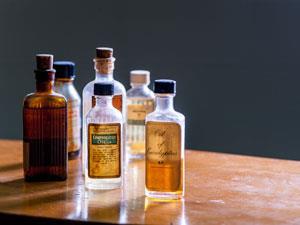First analyses of elixirs, nostrums and other cures sold at the turn of the last century

US scientists have carried out the first analyses of old ‘patent medicines’ - medicinal preparations from the turn of the last century - to identify the chemical constituents of the medications and perhaps determine if there was any truth in the wild health claims they made.
The drugs in question come from a collection of late 19th and early 20th century medicines held in the Henry Ford museum in Dearborn, Michigan, that predate even the earliest US regulatory legislation - the Food and Drug Act of 1906. Operating without regulation and information, the creators of treatments such as ‘Dr Solomon’s Magic Nerve Pills’ are sometimes considered to be snake oil salesman - disingenuous hucksters peddling panaceas to the vulnerable and credulous - but the efficacies and recipes of these untested elixirs are simply not known.
‘[The curators] know from the boxes and newspapers what it was supposed to be for, but they have no idea what’s in it,’ Mark Benvenuto of University of Detroit Mercy, told the 245th ACS National Meeting & Exposition in New Orleans, US, who was approached by the museum’s curators to shed some light on the issue.
Benvenuto and his team conducted x-ray fluorescence (XRF) analyses of the preparations to begin to determine just what these medicines contained. Their results revealed the presence of a range of elements, many of which would be considered beneficial, such as calcium, iron and zinc. ‘It may be a stretch to say this would cure your liver, but it probably was rather healthy,’ says Benvenuto.
However, the team also discovered quantities of mercury and lead, and trace amounts of arsenic, elements whose toxicity is well known. The presence of these heavy metals may be alarming to modern medics but, as Benvenuto notes, even these potentially dangerous concoctions might have been based on established medical practices. ‘100 years ago, mercury was used to cure syphilis. It kills the [infection] - it almost kills you in the process, but it cures the disease.’
The presence of toxic elements is ‘interesting but not surprising,’ says Tsanangurayi Tongesayi of Monmouth University, New Jersey, US, who emphasises it’s the dose that makes the poison. ‘Elements that we know are toxic today were used previously as medicines because they kill cells. All that matters is the dose - the dose that kills a pest will not kill you.’
Benvenuto intends to conduct further analyses to identify the nature of any organic compounds present in the medicines and whether their contents correspond to any known medicinal benefits. ‘I think that a number of these people believed that the pills they were manufacturing were truly helping … I think this actually represents a first step toward modern medicine.’ However, Benvenuto is careful to point out that the rehabilitation of snake oil salesman is beyond the scope of this work. ‘Analytical chemists won’t answer the larger question – you can’t determine intent based on XRF.’






No comments yet